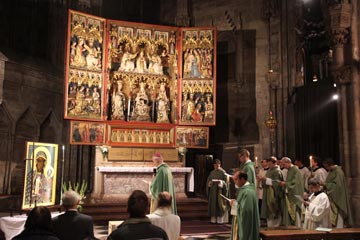Our Blessed Mother in Her Icon of Czestochowa arrived in the heart of the Austrian Church, which is the famous Cathedral of St. Stephen (the first martyr). It is the oldest and most important church in Vienna, and is located right in the center of the old city. As Austria's most eminent Gothic edifice, this cathedral is grouped with some of Europe's largest churches.
Despite of the stormy history of the church, its interior is characterized by the lavishness of the décor, comprised of a wealth of sculptures and paintings dating back to the Middle Ages.
The Czestochowa Icon was placed on a special pedestal next to the famous Altarpiece from Wiener Neustadt (a Gothic winged altar from 15th century), dedicated to the Mother of God. It has been carved in wood, gold plated and poly-chromed, similarly to the Altar of Veit Stoss in Krakow, Poland. A solemn Mass was concelebrated there under the leadership of the Auxiliary Bishop of the Archdiocese of Vienna, Franz Scharl.
The peregrinating Icon of Czestochowa met with another venerated image of the Blessed Virgin Mary at the cathedral – the Maria Pötsch Icon, also called the "Star of the East." This image of the Mother of God was known as the weeping icon in Hungary and became honored as the national object of devotion, to which Prince Eugene of Savoy owed his miraculously secured victory over the Turks at the Battle of Zenta. At the command of Emperor Leopold I, the Pötsch Icon was brought from Hungary (to protect it from the Muslim armies) to Vienna, in a triumphant journey that lasted five months in 1697, where she was recognized as the patroness of the city. On this occasion, the Empress Eleonora Magdalena donated the finest gifts, so that the new object of devotion would receive the most sumptuous framework and revetment (metal cover protecting the icon). In the years 1697-1945, the Icon was placed near the High Altar in the front of the church. Since the post-war renovation of the cathedral, the Icon has been located above an altar under a medieval stone canopy of state (from 1515 A.D.), in the southwest corner of the nave. Many faithful arrive continuously to pray at this place.







